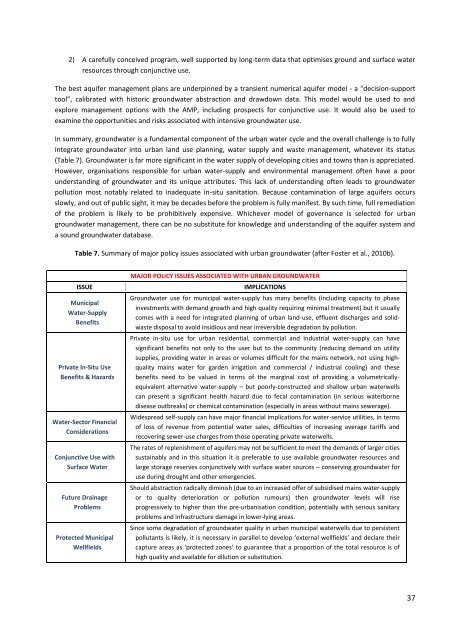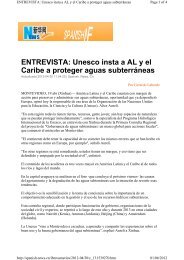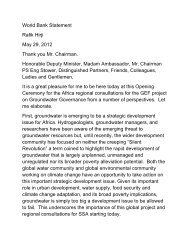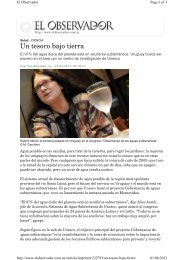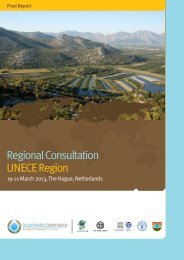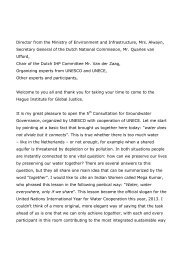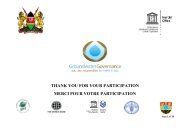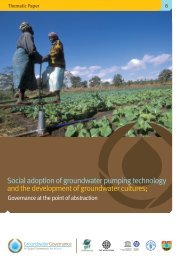Thematic paper 3: Urban-rural tensions - Groundwater Governance
Thematic paper 3: Urban-rural tensions - Groundwater Governance
Thematic paper 3: Urban-rural tensions - Groundwater Governance
Create successful ePaper yourself
Turn your PDF publications into a flip-book with our unique Google optimized e-Paper software.
2) A carefully conceived program, well supported by long-term data that optimises ground and surface waterresources through conjunctive use.The best aquifer management plans are underpinned by a transient numerical aquifer model - a “decision-supporttool”, calibrated with historic groundwater abstraction and drawdown data. This model would be used to andexplore management options with the AMP, including prospects for conjunctive use. It would also be used toexamine the opportunities and risks associated with intensive groundwater use.In summary, groundwater is a fundamental component of the urban water cycle and the overall challenge is to fullyintegrate groundwater into urban land use planning, water supply and waste management, whatever its status(Table 7). <strong>Groundwater</strong> is far more significant in the water supply of developing cities and towns than is appreciated.However, organisations responsible for urban water-supply and environmental management often have a poorunderstanding of groundwater and its unique attributes. This lack of understanding often leads to groundwaterpollution most notably related to inadequate in-situ sanitation. Because contamination of large aquifers occursslowly, and out of public sight, it may be decades before the problem is fully manifest. By such time, full remediationof the problem is likely to be prohibitively expensive. Whichever model of governance is selected for urbangroundwater management, there can be no substitute for knowledge and understanding of the aquifer system anda sound groundwater database.Table 7. Summary of major policy issues associated with urban groundwater (after Foster et al., 2010b).ISSUEMunicipalWater-SupplyBenefitsPrivate In-Situ UseBenefits & HazardsWater-Sector FinancialConsiderationsConjunctive Use withSurface WaterFuture DrainageProblemsProtected MunicipalWellfieldsMAJOR POLICY ISSUES ASSOCIATED WITH URBAN GROUNDWATERIMPLICATIONS<strong>Groundwater</strong> use for municipal water-supply has many benefits (including capacity to phaseinvestments with demand growth and high quality requiring minimal treatment) but it usuallycomes with a need for integrated planning of urban land-use, effluent discharges and solidwastedisposal to avoid insidious and near irreversible degradation by pollution.Private in-situ use for urban residential, commercial and industrial water-supply can havesignificant benefits not only to the user but to the community (reducing demand on utilitysupplies, providing water in areas or volumes difficult for the mains network, not using highqualitymains water for garden irrigation and commercial / industrial cooling) and thesebenefits need to be valued in terms of the marginal cost of providing a volumetricallyequivalentalternative water-supply – but poorly-constructed and shallow urban waterwellscan present a significant health hazard due to fecal contamination (in serious waterbornedisease outbreaks) or chemical contamination (especially in areas without mains sewerage).Widespread self-supply can have major financial implications for water-service utilities, in termsof loss of revenue from potential water sales, difficulties of increasing average tariffs andrecovering sewer-use charges from those operating private waterwells.The rates of replenishment of aquifers may not be sufficient to meet the demands of larger citiessustainably and in this situation it is preferable to use available groundwater resources andlarge storage reserves conjunctively with surface water sources – conserving groundwater foruse during drought and other emergencies.Should abstraction radically diminish (due to an increased offer of subsidised mains water-supplyor to quality deterioration or pollution rumours) then groundwater levels will riseprogressively to higher than the pre-urbanisation condition, potentially with serious sanitaryproblems and infrastructure damage in lower-lying areas.Since some degradation of groundwater quality in urban municipal waterwells due to persistentpollutants is likely, it is necessary in parallel to develop ‘external wellfields’ and declare theircapture areas as ‘protected zones’ to guarantee that a proportion of the total resource is ofhigh quality and available for dilution or substitution.37


